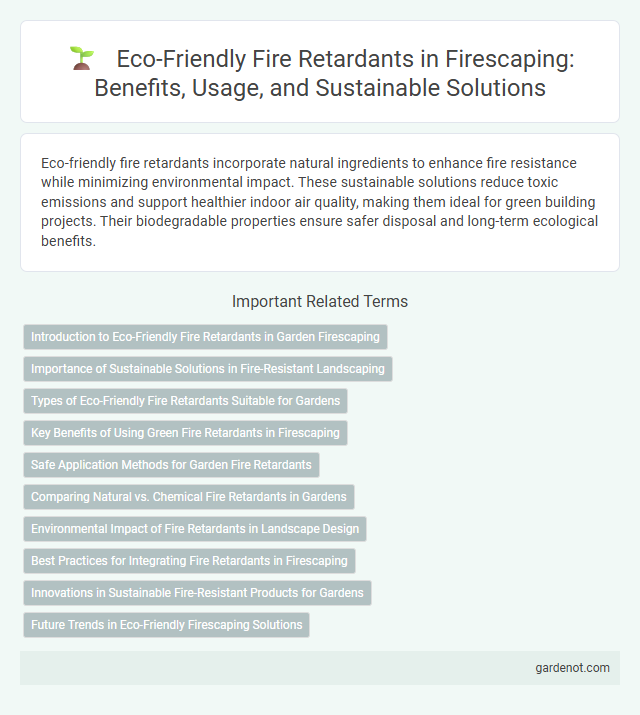Eco-friendly fire retardants incorporate natural ingredients to enhance fire resistance while minimizing environmental impact. These sustainable solutions reduce toxic emissions and support healthier indoor air quality, making them ideal for green building projects. Their biodegradable properties ensure safer disposal and long-term ecological benefits.
Introduction to Eco-Friendly Fire Retardants in Garden Firescaping
Eco-friendly fire retardants in garden firescaping use natural or biodegradable materials to reduce fire risk while minimizing environmental impact. These retardants help protect plants and soil by limiting toxic chemical exposure and promoting sustainable landscape management. Incorporating such products supports fire safety goals without compromising garden health or ecosystem balance.
Importance of Sustainable Solutions in Fire-Resistant Landscaping
Eco-friendly fire retardants are essential in firescaping as they minimize environmental impact while enhancing fire resistance in landscapes. Sustainable fire-resistant landscaping solutions protect ecosystems by reducing harmful chemical runoff and preserving soil health. Implementing these green retardants supports long-term wildfire resilience and promotes biodiversity conservation.
Types of Eco-Friendly Fire Retardants Suitable for Gardens
Eco-friendly fire retardants suitable for gardens include mineral-based compounds such as ammonium phosphate and potassium bicarbonate, which create a protective barrier against flames without harming soil health. Plant-derived retardants like soy protein and starch-based formulations offer biodegradable options that enhance fire resistance while supporting sustainable landscaping practices. Water-based fire retardants, often containing natural clay or silica, provide effective fire suppression with minimal environmental impact, making them ideal for maintaining garden ecosystems.
Key Benefits of Using Green Fire Retardants in Firescaping
Eco-friendly fire retardants in firescaping significantly reduce environmental impact by utilizing biodegradable, non-toxic ingredients that protect soil health and local wildlife. These green fire retardants enhance vegetation safety by creating effective fire barriers without harming plant growth or disrupting ecosystems. Their sustainable nature also minimizes chemical runoff, promoting safer water quality in fire-prone landscapes.
Safe Application Methods for Garden Fire Retardants
Eco-friendly fire retardants for gardens use natural compounds like ammonium phosphate and potassium salts, ensuring minimal environmental impact while enhancing vegetation's fire resistance. Safe application methods include applying these retardants during cooler, calm weather to reduce drift and direct contact with non-target plants, using low-pressure sprayers for even distribution. Proper personal protective equipment (PPE) such as gloves and masks is essential to protect applicators during preparation and spraying, ensuring health safety and environmental stewardship.
Comparing Natural vs. Chemical Fire Retardants in Gardens
Eco-friendly fire retardants in gardens can be classified into natural and chemical types, each with distinct environmental impacts and effectiveness. Natural fire retardants, derived from materials like clay, gypsum, and certain plant extracts, offer biodegradable benefits and lower toxicity, making them safer for local wildlife and soil health. Chemical fire retardants often demonstrate quicker and more potent fire suppression but may introduce pollutants and long-term ecological risks, necessitating careful application in fire-prone landscaping.
Environmental Impact of Fire Retardants in Landscape Design
Eco-friendly fire retardants in landscape design significantly reduce harmful chemical runoff, preserving soil and water quality while protecting native flora and fauna. These sustainable formulations use biodegradable compounds that minimize toxicity to beneficial insects and aquatic life, promoting a healthier ecosystem. Incorporating environmentally safe fire retardants supports fire prevention strategies without compromising biodiversity or long-term environmental health.
Best Practices for Integrating Fire Retardants in Firescaping
Applying eco-friendly fire retardants in firescaping involves selecting non-toxic, biodegradable products that minimize environmental impact while effectively reducing fire risk. Incorporate fire retardants during landscape design by treating key vegetation and mulch layers, ensuring thorough coverage and adherence to manufacturer guidelines for durability and reapplication frequency. Combining fire-resistant plant selection with strategic fire retardant application enhances overall landscape resilience against wildfires, promoting safety without compromising ecological sustainability.
Innovations in Sustainable Fire-Resistant Products for Gardens
Eco-friendly fire retardants for gardens leverage bio-based ingredients such as cellulose, clay minerals, and natural polymers to enhance fire resistance while minimizing environmental impact. Innovations in sustainable fire-resistant products include biodegradable coatings and non-toxic gels that create protective barriers on vegetation, reducing flammability without harming soil health or beneficial insects. These advanced formulations promote safer landscapes and resilience in fire-prone areas by integrating plant-safe materials that degrade naturally over time.
Future Trends in Eco-Friendly Firescaping Solutions
Future trends in eco-friendly firescaping solutions emphasize the development of biodegradable fire retardants derived from organic materials such as plant extracts and mineral-based compounds that minimize environmental impact. Innovations include the integration of nanotechnology to enhance fire-resistant properties while maintaining soil and water health. Growing regulatory support and consumer demand drive the adoption of sustainable firescaping practices that balance fire prevention with ecosystem preservation.
Eco-friendly fire retardant Infographic

 gardenot.com
gardenot.com